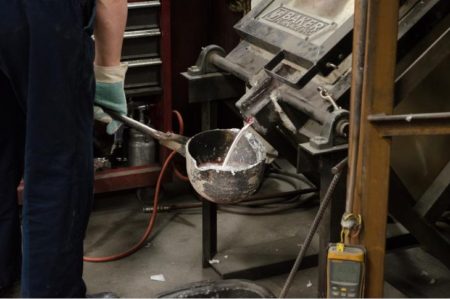Jun
8
Huge Benefits Seen With Aluminum Cerium Alloys
June 8, 2016 | 1 Comment
Researchers have developed aluminum-cerium alloys that are both easier to work with and more heat tolerant than existing products. Aluminum-cerium alloys also promise to boost domestic rare earth mining by increasing the demand and, eventually, the value of cerium. The large team involves research scientists at the Department of Energy’s Oak Ridge National Laboratory (ORNL) partnering Lawrence Livermore National Laboratory and Wisconsin-based Eck Industries.

Alloyed aluminum cerium alloyed metal being poured from a furnace into a ladle, to be used to fill molds. Image Credit: Zachary Sims, ORNL. Click image for the largest view. More images at the Oak Ridge link above with Hi Resolution available.
Heat tolerance and workability are critical aspects of the big volume metals as energy reduction is front and center in engineering and design. Even more useful is using more cerium could increase the U.S.’s own production of other rare earth elements.
The team is working as part of the Critical Materials Institute, an Energy Innovation Hub created by the U.S. Department of Energy (DOE) and managed out of DOE’s Advanced Manufacturing Office. Based at Ames, the institute works to increase the availability of rare earth metals and other materials critical for U.S. energy security.
Rare earth elements are a group of elements critical to electronics, alternative energy and other modern technologies. Modern wind turbines and hybrid powered autos, for example, rely on strong permanent magnets made with the rare earth elements neodymium and dysprosium. Yet there is no production occurring in North America at this time.
One problem is that cerium accounts for up to half of the rare earth content of many rare earth ores, including those in the United States, and it has been difficult for rare earth producers to find a market for all of the cerium mined. The United States’ most common rare earth ore, in fact, contains three times more cerium than neodymium and 500 times more cerium than dysprosium.
There is so much cerium that its a problem instead of a useful income producing product.
ORNL’s Rios said, “We have these rare earths that we need for energy technologies. But when you go to extract rare earths, the majority is cerium and lanthanum, which have limited large-volume uses.”
If, for example, the new alloys find a place in internal combustion engines, they could quickly transform cerium from an inconvenient byproduct of rare earth mining to a valuable product in itself.
“The aluminum industry is huge,” Rios explained. “A lot of aluminum is used in the auto industry, so even a very small implementation into that market would use an enormous amount of cerium.” A 1 percent penetration into the market for aluminum alloys would translate to 3,000 tons of cerium, he added.
Rios said components made with aluminum-cerium alloys offer several advantages over those made from existing aluminum alloys, including low cost, high castability, reduced heat-treatment requirements and exceptional high-temperature stability.
“Most alloys with exceptional properties are more difficult to cast,” said David Weiss, vice president for engineering and research and development at Eck Industries, “but the aluminum-cerium system has equivalent casting characteristics to the aluminum-silicon alloys.”
The key to the alloys’ high-temperature performance is a specific aluminum-cerium compound, or intermetallic, which forms inside the alloys as they are melted and cast. This intermetallic melts only at temperatures above 2,000º Fahrenheit.
That heat tolerance makes aluminum-cerium alloys very attractive for use in internal combustion engines, Rios noted. Tests have shown the new alloys to be stable at 300º Celsius (572º F), a temperature that would cause traditional alloys to begin disintegrating. In addition, the stability of this intermetallic sometimes eliminates the need for heat treatments typically needed for aluminum alloys.
Not only would aluminum-cerium alloys allow engines to increase fuel efficiency directly by running hotter, they may also increase fuel efficiency indirectly, by paving the way for lighter engines that use small aluminum-based components or use aluminum alloys to replace cast iron components such as cylinder blocks, transmission cases and cylinder heads.
The team has already cast prototype aircraft cylinder heads in conventional sand molds. The team also cast a fully functional cylinder head for a fossil fuel-powered electric generator in 3D-printed sand molds. This first-of-a-kind demonstration led to a successful engine test performed at ORNL’s National Transportation Research Center. The engine was shown to handle exhaust temperatures of over 600º Celsius (1112º F).
The alloys were jointly invented by researchers at ORNL and Eck Industries. Colleagues at Eck Industries contributed expertise in aluminum casting, and LLNL researchers analyzed the aluminum-cerium castings using synchrotron source X-ray computed tomography.
This is about as win win win as you can get. Perhaps the team and the institutions can get the automakers attention with these results. The only catch is the price of the tech. It won’t be because of the price of cerium.
Comments
1 Comment so far


Unfortunately, early attempts to incorporate aluminum in auto engines ended with a black eye. Aluminum parts warped when exposed to high heat. Car owners were not happy. Hopefully this alloy will keep aluminum from losing it’s shape.